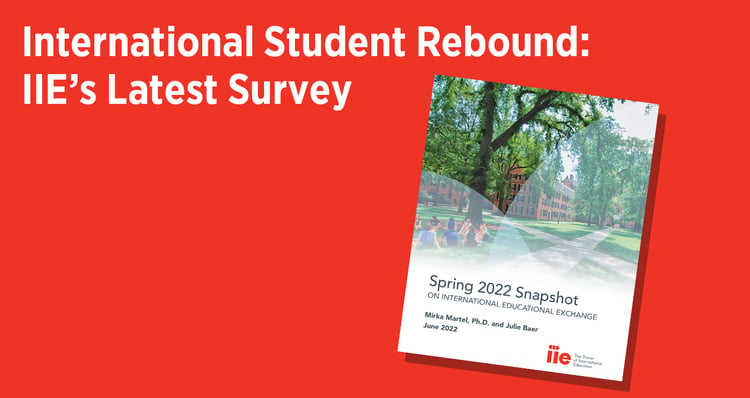
The near-term forecast: sunnier skies for international student recruitment.
That’s according to the “Spring 2022 Snapshot on International Educational Exchange” by the Institute of International Education (IIE). The long-running Snapshot series is part of IIE’s efforts to map the effects of notable current events on international educational exchange to and from the US. This latest release, which analyzes a full 559 institutions that completed the survey, includes the effect of COVID-19 as well as the war in Ukraine.
Look, every time the US suffers a drop due to anti-immigrant rhetoric out of Washington, policies that hinder work opportunities for international graduates, or less controllable obstacles like pandemics and international conflicts, each time these serious situations emerge, there are prognosticators predicting the end of US recruiting strength.
Every year, for more than a decade, at least one-third of US institutions saw a decline in their international student population. During the pandemic, that pain was spread much, much further, and deeper.
The past decade has been full of ups and downs and the US continues to find a welcome international audience despite it all. Opportunities for growth are out there for those institutions willing to put in the effort and make the investment.
Four key findings surfaced from the latest IIE report:
- #1 Most international students studied in person on US campuses in spring 2022.
- #2 US colleges and universities are supporting international students during the Ukraine crisis.
- #3 International student applications continued to increase.
- #4 In-person study abroad rebounds.
Offering up a few road signs to point you in the right direction
A report is just a report until you put it to use. Read on to better understand how you can use the survey to bolster your recruitment strategy this fall as well as learn what others are already doing.
As @KarinFischer of The Chronicle of Higher Education points out in a June 23 article, international enrollments increased 4% last fall and new application data suggests the rebound will continue. Clearly, there was a big drop to rebound from.
Head IIE researcher @MirkaMartel agrees, telling Fischer the data “leaves us quite optimistic about the future of international students in the United States.” Following are your key takeaways from IIE’s spring Snapshot survey. And, to read the full report, click here.
Key Finding #1: Most international students studied in person on US campuses in spring 2022.
The stats:
- 99% of US higher education institutions reported having in-person classes in spring 2022
- 89% said over half of their international students were on campus
- 55% of respondents reported that all their international students attended classes in person this past spring, compared to just 8% a year ago (talk about a rebound!)
- 89% continue to communicate with international students about their health and wellbeing, and 61% communicate about mental health
Notably, of the 559 responding institutions, only 4 provided virtual teaching exclusively (3 of which are special focus institutions). The remaining 99% offered hybrid (71%) or in-person only (28%). Looking more closely, in-person study was highest among Baccalaureate colleges (59% offered in-person only) and lowest among Associate’s or community colleges (5% in-person study only).
Clearly, remote learning is more prevalent, in part because it offers greater access to many who were previously shut out.
The report’s authors believe, as do we, that higher ed institutions in the US will either maintain or increase their flexibility in how they provide instruction.
Truth is, 85% of the respondents already offered hybrid instruction prior to the pandemic and the vast majority intend to continue with this approach. Of those that did not, 54% plan to offer a hybrid format of sorts moving forward. Only 7% said they have no plans to offer virtual classes in the future. Flexible modality, it seems, is here to stay.
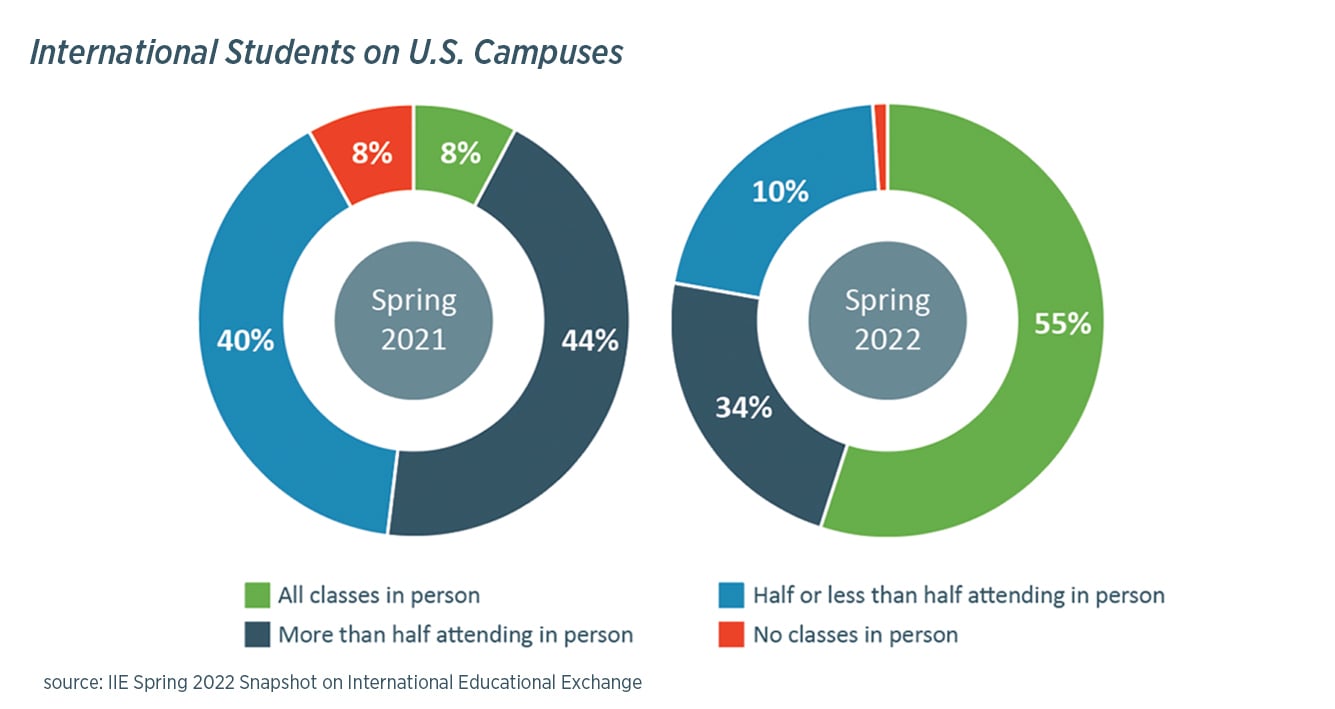
Your to-do
Highlight your institution’s ability to adapt to students’ evolving needs and the successful students accessing those programs. Have current students help tell the story. When real students talk about their real experiences, prospective students listen. Need help crafting compelling stories for your student recruiting campaigns? Be in touch.
Key Finding #2: US colleges and universities are supporting international students during the Ukraine crisis.
More than 1,700 students from Ukraine were studying in the US during the 2020-21 academic year. And, as the report so aptly states, the Ukrainian higher education system has been gravely affected by the conflict and, with it, the realities for international students studying in Ukraine and abroad.
This past spring, 248 responding institutions hosted students from Ukraine. They supported these students through written correspondence (87%), mental health counseling (81%), emergency student funding (59%), and housing (29%). Likewise, 307 of the institutions hosted students from Russia and provided similar support to them.
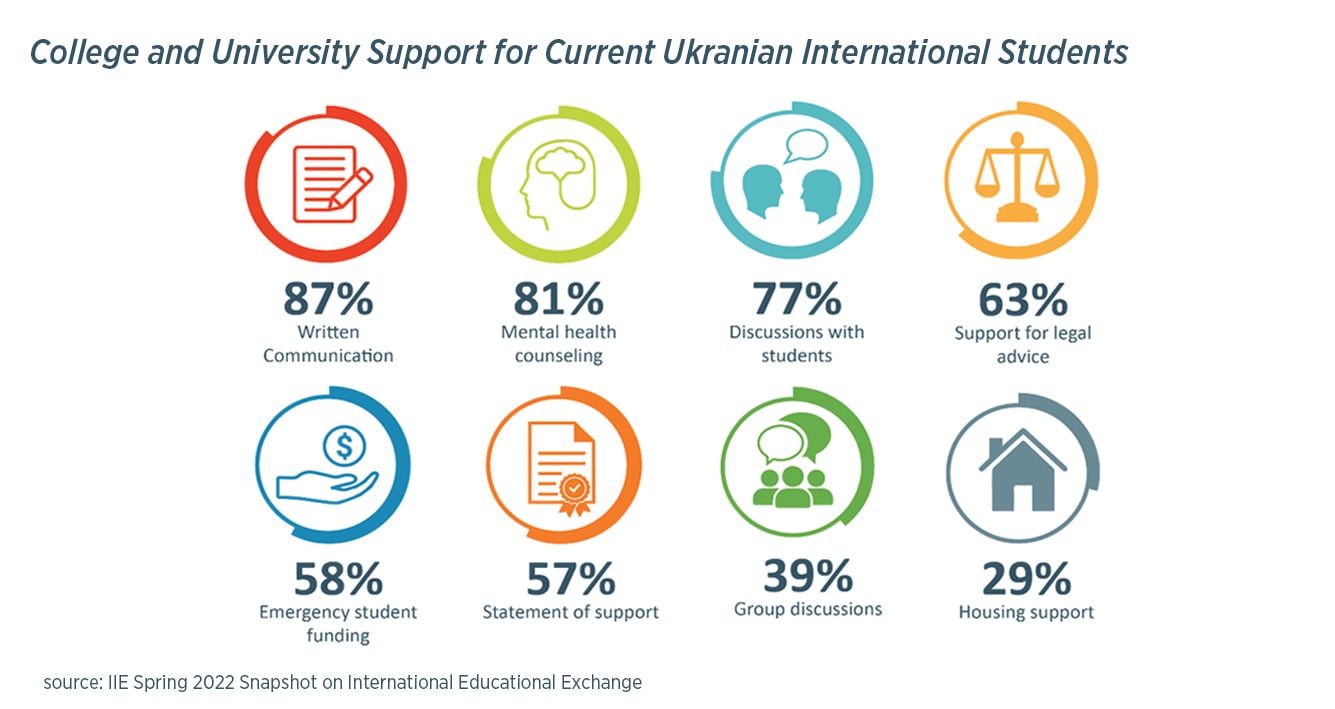
Your to-do
Support these students! These opportunities to do the right thing and showcase how your institution truly stands behind its student-first policies are incredibly important. Provide focused and personal outreach (check-ins), topical forums, supportive chat groups, funds if student cash flow has been disrupted, mental health services, and any other creative ideas that emerge on your campus based on your students’ needs. Your efforts to support go beyond an inspiring message from your leadership and a Ukrainian flag icon on your social channels. Your sustained student support will be recognized by your larger audience.
Key Finding #3: International student applications continue to increase.
The stats:
- 65% of responding institutions saw an increase in international student applications for 2022-23, up from 43% a year ago
- 43% of institutions note in-person recruitment
- 96% are offering in-person study to future international students with options for online study decreasing
Heartening news, indeed. As we all know so well, the pandemic caused an unwelcome 15% decrease in international student numbers. IIE tells us the downturn was primarily among new international students or those studying in the US for the first time. By fall 2021, however, IIE was seeing a 4% increase in total international student numbers—the first indication of a rebound of international students.
During Covid, we’ve all worked hard to adapt our application processes to make it easier for prospective students. Namely, we’ve embraced a more digitized process. 84% of survey respondents report offering online submission of applications, 80% offer online immigration documentation, and 54% allow online results instead of in-person testing. Many (28%) have also extended application deadlines. Acceptance of digital signatures helped as well.
What we still don’t really know:
- Will access to US Visa appointments improve in time for fall student orientations?
- Will all those fresh applicants actually show up?
A healthy skepticism here will prompt you to have backup plans in place and set enrollment expectations within your institution.
Your to-do
Adapt. (Sense a theme here?)
Make it easy for students to apply online. Lend a hand. Walk them through it. Whether a prospect comes to you via social media, your website, QR code, etc., make sure your application is one click away. Then, literally, spell out the steps to the process. Think this is intuitive? Of course, it is. But you’d be surprised how many institutions make accessing and completing the application more difficult than it needs to be. Put your UX (User Experience) folks on it. If you don’t have any, be in touch.
Key Finding #4: In-person study abroad rebounds.
The stats:
- 58% of the institutions are offering in-person study abroad programs this summer, and an additional 31% are offering hybrid programs
- 65% of study abroad programs will be in person this fall
- 83% of institutions report an increase in study abroad numbers this coming year
- 81% require students to have a Covid-19 vaccine to study abroad
The long and the short of it is: study abroad is back. Last summer (2021), 43% of institutions canceled study abroad programs. Now, less than 1% anticipate study abroad cancellations for spring 2023. Still, institutions learned from the pandemic and as a result, many are expanding online global learning opportunities.
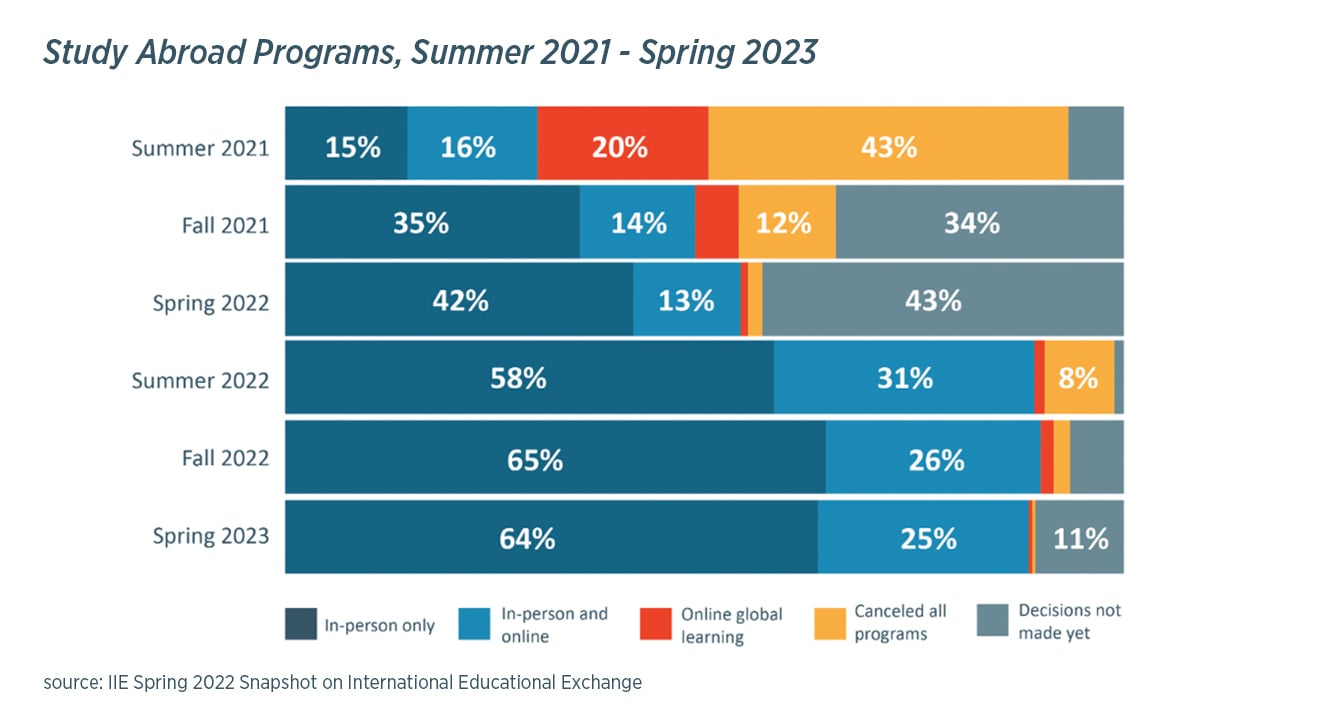
Your to-do
Study abroad is on. If your institution isn’t yet on board, then you’re losing an opportunity to connect with students looking for these short-term programs. And if your institution is offering study abroad, make sure students know. It can be a tough sell sometimes, but the data tells us that a higher percentage of students succeed when their university experience includes study abroad. If you need help with a study abroad campaign strategy, be in touch.
BONUS Key Finding: How your peer institutions are recruiting international students now.
The report is chock-full of insights you’ll find interesting. One more nugget we’d like to highlight here is the resources responding institutions say they’re using now to recruit international students—the same prospects you’re likely after as well.
- 91% are working with current international students to help recruit prospects
- 89% are hosting online recruitment events and 65% offer virtual campus visits
- 73% are using social media
- 72% focus on international partnerships and 67% use agents
- 68% tap alumni for assistance
- 43% are hosting in-person recruitment events
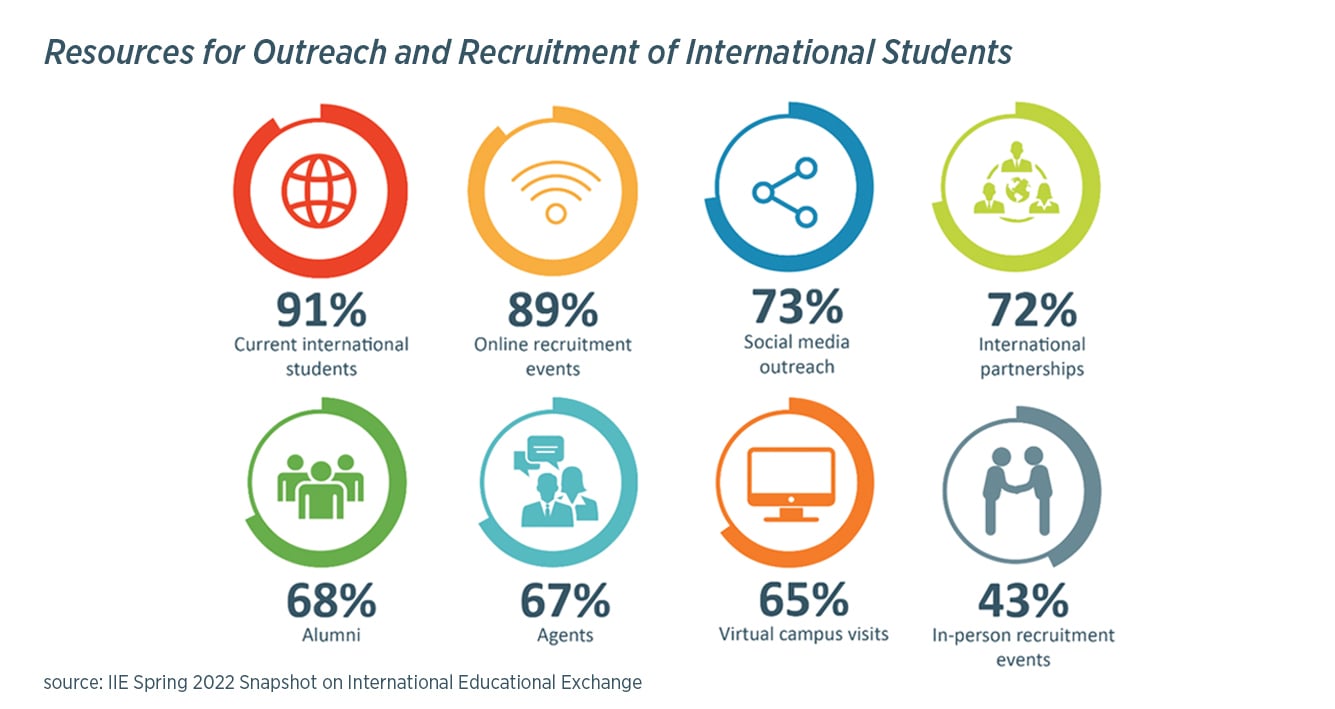
Your to-do
Know what’s working and what’s not for your industry as a whole and make sure you’re ahead of the competition. Students have so many choices to make. Why should they consider your institution, much less choose it as their destination?
Serial industry data like this from IIE are so helpful in gauging where we are now in comparison to where we've been. All this points to a more effective future. If you’d like to discuss how these findings should impact your specific recruitment plans, once again: be in touch.



